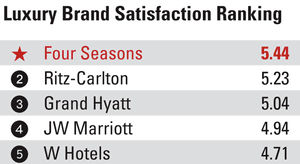Four Seasons is back on top after placing second in 2014 behind Mandarin Oriental, which dropped out of this year’s survey entirely. Four Seasons is no stranger to first place though, having come in at No. 1 in 2013, 2011 and every year from 2006 to 2009. “[Corporate travelers] have fueled
our success and expansion from the beginning,” said Four Seasons senior vice president of global sales Jonathan Sicroff. “Corporate travelers really appreciate and need our services. We try to get the basics right and try to make our facilities and locations appropriate for them.”

The brand swept nearly every category rated by travel buyers, from quality of sales staff to overall price/value. It also received a higher overall score than last year’s victor. Sicroff attributes its success to recent introductions like beds with interchangeable soft, medium and firm
mattress toppers and 15-minute room service for select menu items.
Looking ahead, Four Seasons is “reimagining the entire guest experience, from a physical aspect, to the bathrooms, to the public space … to interacting with travelers along their journey,” said Sicroff. A key piece of that initiative is Four Seasons’ mobile app, which was introduced in June and
serves as an interface between guests and onsite service and delivery teams. The app enables guests to check in, check out, browse local recommendations, order room service, make spa or restaurant reservations, submit housekeeping requests and contact the concierge. “It allows the traveler on the road to
access any of the hotel services that they need,” Sicroff said. Four Seasons also is upgrading its Wi-Fi to offer one-click connection at a faster speed for an unlimited number of devices.
Ritz-Carlton also is familiar with the top of the BTNsurvey. It finished No. 1 in the luxury segment in 2010 and has finished in the upper end since, taking second place this year and receiving the highest score for quality of data. “We start with our top [corporate] customers that have
global travel needs and work with them very strategically at a pretty high level,” said Ritz-Carlton vice president of sales John Harper. “We ask specifically what’s going on, what’s trending in their world and what can we do to help accommodate them and work more closely together with them. How that
information gets carried through the organization helps us make a pretty big difference in how we approach the segment.”
Ritz-Carlton recently adopted a slight redesign of its brand logo, introducing a light blue background and more modern text, as part of a new brand voice geared at reaching a new generation of guests. The brand continues to see positive results from its rewards program and property renovations,
as well as its mobile app, which allows guests to check in, check out and place service requests. “We’ve been very committed to having an app and using mobility to help, not take away from, our legendary service,” Harper said. “We’re very surprised at how frequently customers are using it. We had an
expectation, but it’s exceeding that expectation.”
The average overall score for the luxury tier this year topped last year’s, suggesting that travel buyers aren’t as disenchanted with luxury as they had been in the recent past. Metrics for luxury hotels are also positive. From January through August, U.S. demand growth reached 0.9 percent,
topping the period’s 0.4 percent supply growth. And August occupancy rose 0.5 percent year over year to 76.5 percent, according to STR.
As for U.S. pipeline development, the luxury segment reported the largest year-over-year increase in rooms under contract during August 2015, rising 55.9 percent to 11,434 rooms, according to STR. It also saw a 63.5 percent year-over-year increase of rooms under construction, to 5,927
rooms.
This report originally appeared in the Oct. 12, 2015
edition of Business Travel News.